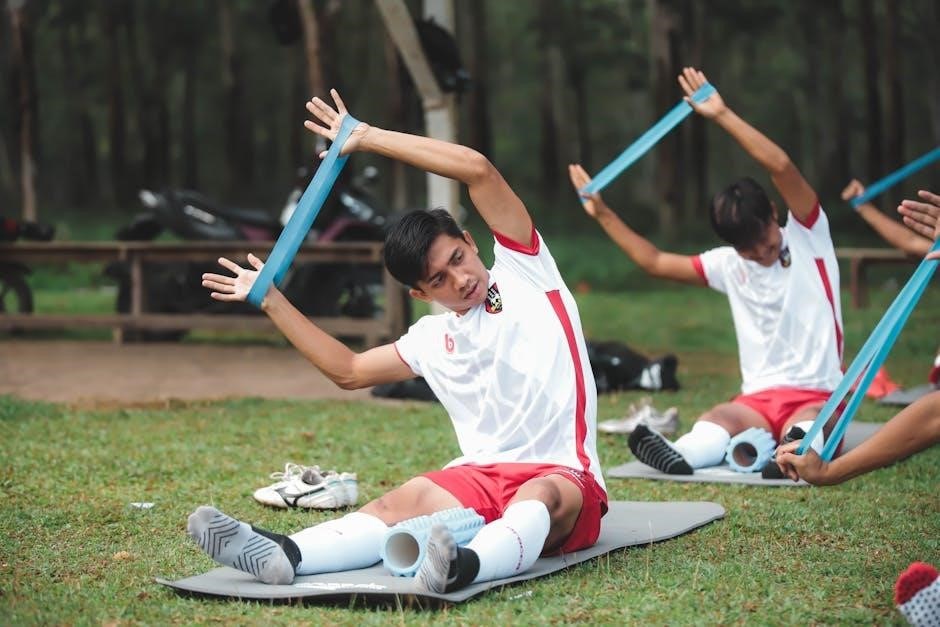
-
By:
- collin
- No comment
trampoline net instructions
This guide provides essential instructions for installing‚ maintaining‚ and ensuring the safety of your trampoline net. Proper setup is key to preventing accidents and ensuring durability for safe play environments.
Importance of Trampoline Safety

Trampoline safety is paramount to prevent injuries and ensure a secure environment for users‚ especially children. Each year‚ thousands of trampoline-related injuries occur‚ often due to improper setup or lack of safety measures. A trampoline net acts as a protective barrier‚ reducing the risk of falls and collisions. It also helps contain jumpers within the trampoline area‚ minimizing accidents caused by overstepping or losing balance. Additionally‚ a well-installed net can prevent contact with springs or hard frame components‚ which are common causes of injury. Regular inspections and proper maintenance of the net are essential to uphold safety standards. By prioritizing trampoline safety‚ you create a fun and secure space for everyone to enjoy.
Overview of Trampoline Net Components
A trampoline net is typically composed of several key components designed to ensure safety and durability. The net itself is usually made of durable‚ weather-resistant material like polypropylene or polyester mesh. The enclosure poles‚ often made of steel or fiberglass‚ provide structural support and hold the net upright. Springs or straps are used to attach the net securely to the trampoline frame‚ ensuring a tight fit. Additionally‚ a top ring or pole may be included to maintain the net’s shape and stability. These components work together to create a safe and secure environment for jumpers‚ preventing falls and injuries. Understanding each part is crucial for proper installation and maintenance.

Preparation Before Installing the Trampoline Net
Preparing the installation area involves ensuring a stable‚ level ground and a secure trampoline frame to guarantee a safe and proper trampoline net setup.
Gathering Necessary Tools and Accessories
To begin the installation process‚ gather all essential tools and accessories. These typically include a screwdriver‚ pliers‚ wrench‚ and gloves for handling hardware. Ensure you have the trampoline net‚ springs‚ straps‚ and any additional components provided by the manufacturer. Check the packaging for hardware like bolts‚ nuts‚ and clips‚ which are crucial for securing the net. Review the list of included items in the manufacturer’s manual to confirm nothing is missing. Organize these tools and parts in a workspace to streamline the assembly process. Having everything ready beforehand saves time and ensures a smooth installation. Additionally‚ consider having a ladder or step stool for reaching the trampoline frame safely. Always prioritize safety by wearing protective gear like gloves to prevent injuries during setup.
Choosing the Right Trampoline Net Size
Choosing the correct trampoline net size is crucial for safety and proper installation. Measure the diameter of your trampoline accurately‚ ensuring the net matches the frame’s dimensions. Consider the spring size and the distance between the springs‚ as these factors affect the net’s fit. A net that is too small may not cover the springs properly‚ while one that is too large may sag or become loose. Check the manufacturer’s specifications for compatibility‚ as different trampoline models may require unique net sizes. Additionally‚ consider the shape of your trampoline—whether it’s round‚ rectangular‚ or oval—and select a net designed for that shape. A well-fitting net ensures optimal safety and performance‚ preventing accidents and prolonging the net’s lifespan.
Reading the Manufacturer’s Instructions
Reading the manufacturer’s instructions is a critical step in ensuring the trampoline net is installed correctly and safely. These instructions are tailored to your specific trampoline model‚ providing detailed guidance on assembly‚ safety precautions‚ and maintenance. They often include diagrams and step-by-step procedures to help you understand the process clearly. Failure to follow the instructions can lead to improper installation‚ which may compromise the net’s effectiveness and increase the risk of accidents. Pay special attention to safety recommendations‚ such as weight limits and usage guidelines. Additionally‚ the manual may include troubleshooting tips for common issues. Always keep the instructions handy for future reference‚ especially for maintenance or repairs. By adhering to the manufacturer’s guidelines‚ you can ensure a safe and enjoyable experience for everyone using the trampoline.

Understanding Trampoline Net Assembly
Assembly involves attaching the net securely to the trampoline frame using provided hardware. Follow step-by-step instructions to ensure a safe and durable installation for optimal performance.
Unpacking and Organizing the Net Hardware
Begin by carefully unpacking all components‚ including poles‚ springs‚ and clips. Separate and categorize each part to ensure nothing is missing. Refer to the provided instructions for a detailed inventory list. Organize the hardware in a logical order‚ grouping similar parts together. This step is crucial for efficient assembly and to prevent losing small items. Lay out the components in a clean‚ open space to avoid misplacement. Verify that all tools required for assembly are available. Double-check the instructions to understand the purpose of each part before proceeding. Proper organization ensures a smooth and safe assembly process.
Attaching the Net to the Trampoline Frame

To securely attach the trampoline net to the frame‚ start by aligning the net’s attachment points with the frame’s hooks or brackets. Use the provided springs‚ straps‚ or clips to fasten the net evenly around the perimeter. Ensure the net is centered and evenly spaced to maintain structural integrity. Tighten each connection gradually to avoid uneven tension. Double-check that all hardware is properly secured and that the net is tightly fitted to the frame. If using springs‚ attach them to the frame and net in a consistent pattern. Make sure there are no loose ends or gaps where the net meets the frame for optimal safety and performance. Proper alignment and secure fastening are critical to prevent accidents and ensure longevity.
Securing the Net with Springs or Straps
To ensure a safe and stable trampoline net‚ properly securing it with springs or straps is crucial. Begin by attaching the springs or straps to the trampoline frame and net‚ ensuring they are tightly fastened. For springs‚ hook one end to the frame and the other to the net’s edge‚ tightening until taut. Straps should be looped through designated holes and securely buckled. Check each connection for firmness‚ as loose attachments can lead to sagging or detachment. Start at the bottom and work your way up for even tension. Use a wrench to tighten springs firmly‚ and for straps‚ ensure buckles are fully engaged. Properly secured springs or straps will prevent the net from shifting during use‚ enhancing safety and durability.
Tightening the Net for Optimal Safety
Tightening the trampoline net is a crucial step to ensure optimal safety and prevent accidents. Start by checking all attachment points and springs for looseness. Use the provided tools‚ such as a wrench or screwdriver‚ to tighten any loose connections. Ensure the net is evenly tensioned across the frame to avoid sagging or uneven surfaces. Over-tightening should be avoided to prevent damage to the net material or frame. Once tightened‚ test the net by gently pulling on it to ensure stability. Regular tightening is necessary‚ especially after heavy use or adverse weather conditions. Proper tension guarantees a safer jumping experience and extends the lifespan of the trampoline net.
Installing the Trampoline Enclosure
Installing the trampoline enclosure involves securely attaching the net to the enclosure poles and ensuring a stable connection for safe jumping experiences and durable performance over time.
Connecting the Net to the Enclosure Poles
Connecting the trampoline net to the enclosure poles is a critical step for ensuring stability and safety. Begin by aligning the net’s attachment points with the poles‚ typically using hooks‚ straps‚ or clips provided in the kit. Secure each connection firmly‚ ensuring the net is evenly distributed around the enclosure. Tighten all fasteners to prevent looseness‚ and double-check that the net is taut and properly aligned. If the net sags or appears misaligned‚ adjust the connections accordingly. Properly securing the net to the poles ensures the enclosure remains stable during use‚ reducing the risk of accidents. Always refer to the manufacturer’s instructions for specific attachment methods‚ as designs may vary. A secure connection is essential for optimal safety and performance.
Ensuring the Enclosure is Securely Fastened
To ensure the trampoline enclosure is securely fastened‚ start by checking all connections between the net and the poles. Use the provided straps or clips to tighten any loose areas. Make sure the net is evenly distributed around the frame and that no gaps exist. Double-check the straps at the top and bottom of the enclosure poles to ensure they are tightly secured. For added safety‚ consider adding extra safety straps or clips if provided. After installation‚ inspect the enclosure by gently tugging on the net and poles to confirm stability. Ensure the net is taut and the entire structure feels sturdy. Repeat this process periodically‚ especially after heavy use or extreme weather conditions.
- Check all connections for tightness.
- Use straps or clips to secure the net.
- Ensure no gaps exist between the net and frame.
- Double-check all straps and clips for stability.
Loose connections can lead to accidents‚ so thorough inspection is crucial. Regular checks will help maintain the enclosure’s integrity and ensure safe trampoline use for everyone.
Checking the Stability of the Enclosure
After installing the enclosure‚ it’s crucial to check its stability to ensure safety. Start by gently shaking the enclosure poles to verify they are securely anchored to the trampoline frame. Check that the net is evenly attached to all poles without sagging or unevenness. Inspect the connections between the net and the enclosure poles to ensure they are tightly fastened. Look for any gaps or loose points that could compromise stability. Finally‚ test the enclosure by applying gentle pressure to confirm it can withstand normal use without wobbling or shifting. A stable enclosure provides a safer environment for jumpers and prevents potential accidents.
- Shake the enclosure poles gently to test their secureness.
- Ensure the net is evenly attached to all poles.
- Check all connections for tightness and proper alignment.
- Apply gentle pressure to test the enclosure’s durability.

Testing the Trampoline Net Setup
Testing ensures the net is securely attached‚ springs are tight‚ and the setup is stable. Always inspect for gaps or weak points before allowing children to play safely.
Inspecting the Net for Gaps or Looseness
Regularly inspect the trampoline net for gaps‚ holes‚ or loose connections to ensure safety and durability. Start by walking around the net and visually checking for any tears or worn areas. Use your hands to feel for loose strands or weak spots‚ especially around the edges where the net attaches to the frame. Pay special attention to the stitching and any points where the net connects to the springs or straps. If you find any gaps‚ tighten the connections or repair the net immediately. Loose areas can lead to accidents‚ so ensuring the net is taut and secure is crucial. Always perform this check before allowing anyone to use the trampoline to guarantee a safe experience.
Testing the Bounce and Safety Features
After setting up the trampoline net‚ test the bounce by gently jumping in the center. Gradually increase the intensity to ensure the net responds evenly and retains its shape. Check the safety features‚ such as the enclosure net and springs‚ to ensure they hold firm under stress. Start with lighter individuals and progress to heavier users to confirm the system’s stability. Pay attention to any sagging or unevenness‚ which may indicate improper tightening or damage. Ensure the weight limit is not exceeded and that the net provides consistent support. Finally‚ inspect all components for any signs of strain or weakness after testing. This step ensures the trampoline is safe and functional for everyone.
Ensuring All Hardware is Properly Tightened
After assembling and securing the trampoline net‚ it’s crucial to ensure all hardware components‚ such as springs‚ straps‚ and bolts‚ are tightly fastened. Use a wrench or screwdriver to double-check each connection‚ applying even pressure to avoid over-tightening‚ which could damage the equipment. Pay special attention to the net’s attachment points to the trampoline frame and enclosure poles‚ as these bear the most stress during use. Regularly inspect and tighten any loose parts‚ especially after heavy use or harsh weather conditions like strong winds or rain. Properly secured hardware ensures the net remains stable‚ preventing accidents and extending the lifespan of your trampoline net. This step is vital for maintaining safety and durability over time.

Maintenance and Care of the Trampoline Net
Regular cleaning prevents dirt buildup‚ while inspections ensure safety and durability. Replacing worn or damaged parts promptly maintains the net’s integrity and ensures safe trampoline use for everyone.

Cleaning the Trampoline Net Regularly
Cleaning the trampoline net is crucial for maintaining its condition and ensuring safe use. Start by removing loose debris like leaves or dirt using a soft-bristled brush or your hands. For tougher stains or mold‚ mix mild soap with warm water and gently scrub the net using a non-abrasive sponge or cloth. Avoid harsh chemicals or abrasive cleaners‚ as they may damage the material. Rinse thoroughly with a garden hose to remove soap residue. Allow the net to air dry completely to prevent moisture buildup‚ which can lead to mold or mildew. Regular cleaning not only enhances safety but also extends the net’s lifespan and keeps it looking its best.
- Use mild soap and water for cleaning.
- Avoid harsh chemicals or abrasive tools.
- Rinse and dry thoroughly after cleaning.
Inspecting the Net for Damage or Wear
Regularly inspecting your trampoline net for damage or wear is crucial for maintaining safety and preventing accidents. Check the net after each use‚ especially if it’s frequently used‚ and before the start of a new season. Look for frayed edges‚ holes‚ or sagging areas‚ as these can lead to breaks during use. Pay attention to the attachment points and springs‚ ensuring they are secure and free from rust. Also‚ examine the stitching for any signs of loosening‚ which could weaken the net’s structure. If you notice any damage‚ stop using the trampoline immediately until repairs or replacements are made. Neglecting these inspections can result in serious injuries‚ so stay vigilant to ensure everyone’s safety while enjoying the trampoline.
Replacing Damaged or Worn-Out Parts
Regularly inspecting and replacing damaged or worn-out parts of your trampoline net is crucial for maintaining safety and performance. Over time‚ components like the netting‚ springs‚ or straps may deteriorate due to weather‚ heavy use‚ or accidental damage. When you notice tears‚ frays‚ or loose connections‚ act promptly to replace them. Always use replacement parts that are compatible with your trampoline model to ensure a proper fit and functionality. Follow the manufacturer’s instructions for removal and installation to avoid further damage or unsafe conditions. Keeping your trampoline net in good condition helps prevent accidents and extends its lifespan. Remember‚ safety should never be compromised by neglecting worn-out parts.

Tips for Safe Trampoline Net Usage
Always follow weight limits‚ supervise children‚ and avoid using the trampoline in harsh weather conditions to ensure a safe and enjoyable experience for everyone involved.
Following Weight Limits and Safety Guidelines
Adhering to weight limits and safety guidelines is crucial for preventing accidents and ensuring the longevity of your trampoline net. Always check the manufacturer’s recommended weight capacity and communicate it to all users. Exceeding these limits can lead to equipment damage or injury. Additionally‚ enforce rules like no somersaults or flips unless the trampoline is designed for such activities. Supervise children to ensure they follow these guidelines and avoid overcrowding the trampoline. Combining weight limits with proper installation and regular maintenance creates a safer environment for everyone to enjoy.
Supervising Children During Use
Supervising children during trampoline use is crucial for ensuring their safety. Always maintain a watchful eye to prevent accidents and ensure proper net usage. Adults should be present to enforce safety rules‚ such as no somersaults or flipping without proper training. Supervision helps identify and correct risky behaviors‚ like jumping too close to the edges or pushing others. It also allows adults to intervene quickly in case of emergencies. Teach children to take turns and avoid overcrowding the trampoline‚ as collisions can occur. Never leave children unsupervised‚ even with a net‚ as their judgment may not align with safety practices. Stay alert and avoid distractions like phones to provide immediate assistance when needed.
Avoiding Hazardous Weather Conditions
Avoid using the trampoline during hazardous weather conditions to ensure safety. Strong winds can damage the net or displace the trampoline‚ while heavy rain or snow can weaken the structure. Lightning storms pose a significant risk‚ as metal parts can conduct electricity. Always remove the net during extreme weather to prevent tears or damage. Secure the trampoline frame tightly to the ground to avoid it being lifted by strong gusts. Never allow children to play on a wet or icy trampoline‚ as this increases the risk of slips and falls. Regularly inspect the net after harsh weather for signs of wear or damage. By taking these precautions‚ you can protect both the trampoline and its users from potential harm.

Troubleshooting Common Issues
Identify and resolve common trampoline net problems like sagging‚ loose attachments‚ or broken springs. Regular inspections and prompt repairs ensure safety and extend the net’s lifespan.
Dealing with a Sagging Trampoline Net
A sagging trampoline net can compromise safety and performance. Check if the net is properly attached to the frame and springs. Tighten any loose connections or springs. Ensure the net is evenly tensioned around the perimeter. If the sagging persists‚ inspect for worn-out or stretched springs and replace them as needed. Regularly check the net’s attachment points and re-tighten them to maintain optimal tautness. Addressing the issue promptly prevents accidents and ensures a safe bouncing experience for users.
Fixing a Loose or Detached Net
If your trampoline net becomes loose or detached‚ it’s essential to address the issue promptly to ensure safety. Start by inspecting the net’s connection points to the trampoline frame. Check for any worn-out or damaged springs‚ straps‚ or clips. Tighten all loose hardware and replace any broken components. Ensure the net is evenly spaced and aligned properly around the frame. If the net has come detached‚ reattach it securely‚ making sure all straps or springs are properly hooked. Test the net by gently pulling on it to ensure it’s taut and firmly in place. If the problem persists‚ consult a professional or refer to the manufacturer’s troubleshooting guide for further assistance. Regular maintenance can help prevent such issues from arising.
Addressing Broken or Damaged Springs
Broken or damaged springs can compromise the safety and functionality of your trampoline net. If a spring is broken‚ stop using the trampoline immediately to avoid further damage or accidents. To repair‚ gather replacement springs and a spring tool. Remove the damaged spring by detaching it from the trampoline frame and net. Install the new spring securely‚ ensuring it is tightly attached. Double-check all springs to ensure they are properly aligned and tightened. If unsure about the process‚ consult a professional for assistance. Regularly inspect springs for wear or rust to prevent future issues and maintain the trampoline’s stability and safety.
Properly following these instructions ensures a safe and durable trampoline net‚ providing years of enjoyable and secure play for everyone involved in trampoline activities!
Final Thoughts on Trampoline Net Safety
Ensuring your trampoline net is properly installed and maintained is crucial for safe and enjoyable play. Regular inspections and timely repairs prevent potential hazards‚ while following manufacturer guidelines guarantees optimal performance. By adhering to weight limits and supervising children‚ you create a secure environment for everyone. Investing in a high-quality net and enclosure system is a wise decision to protect users and extend the product’s lifespan. Always prioritize safety over convenience‚ and consider professional assistance if unsure about any step. Remember‚ a well-maintained trampoline net not only enhances safety but also ensures years of fun and active play for the whole family!
Encouraging Responsible Trampoline Use
Encouraging responsible trampoline use is essential for ensuring safety and extending the lifespan of the equipment. Always remind users to follow weight limits‚ avoid risky maneuvers‚ and refrain from using the trampoline in poor weather conditions. Supervision by adults is crucial‚ especially for younger children‚ to prevent accidents and misuse. Teach jumpers to land correctly and avoid colliding with others. Regularly inspecting the trampoline net and springs can help identify potential hazards before they cause harm. By promoting a culture of safety and responsibility‚ you create a fun and secure environment for everyone to enjoy. Proper care and adherence to guidelines ensure years of safe and enjoyable trampoline experiences for the whole family.